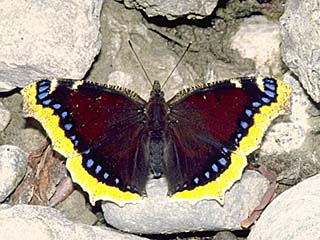 Camberwell BeautyNymphalis antiopa (Linnaeus, 1758)Mourning CloakCamberwell Beauty
Camberwell BeautyNymphalis antiopa (Linnaeus, 1758)Mourning CloakCamberwell Beauty
One of many Camberwell Beauties (Nymphalis antiopa) sucking liquids on a river bank
The  Camberwell BeautyNymphalis antiopa (Linnaeus, 1758)Mourning CloakCamberwell Beauty is widespread throughout Europe up to the far north.
Camberwell BeautyNymphalis antiopa (Linnaeus, 1758)Mourning CloakCamberwell Beauty is widespread throughout Europe up to the far north.
It is absent (or is at best a rare visitor) in central/southern  Portugal
Portugal Portugal/
Portugal/ Spain
Spain Spain, on most Mediterranean islands (exception: Ibiza), on the British Isles and in north-west Scandinavia Kudrna; Harpke; Lux; Pennerstorfer; Schweiger; Settele; Wiemers, 2011 - Distribution Atlas of Butterflies in Europe.
Spain, on most Mediterranean islands (exception: Ibiza), on the British Isles and in north-west Scandinavia Kudrna; Harpke; Lux; Pennerstorfer; Schweiger; Settele; Wiemers, 2011 - Distribution Atlas of Butterflies in Europe.
In the Alps, the  Camberwell BeautyNymphalis antiopa (Linnaeus, 1758)Mourning CloakCamberwell Beauty can sometimes be found at altitudes above 2000 metres Moucha; Choc, 1968 - Taschenatlas der Tagfalter.
Camberwell BeautyNymphalis antiopa (Linnaeus, 1758)Mourning CloakCamberwell Beauty can sometimes be found at altitudes above 2000 metres Moucha; Choc, 1968 - Taschenatlas der Tagfalter.
In Western Europe, the transition area between oceanic- (here: atlantic-) and Types of climate outside the tropics that are characterised by large seasonal fluctuations in monthly average temperatures of over 20 °C. Source: Wikipedia.continental-climate forms the boundary of the spread.
Overall, the butterfly is found on about half of the European land area Kudrna; Harpke; Lux; Pennerstorfer; Schweiger; Settele; Wiemers, 2011 - Distribution Atlas of Butterflies in Europe.
Although it can be common in places, populations of the  Camberwell BeautyNymphalis antiopa (Linnaeus, 1758)Mourning CloakCamberwell Beauty's have declined sharply in recent decades, especially in Central Europe.
Camberwell BeautyNymphalis antiopa (Linnaeus, 1758)Mourning CloakCamberwell Beauty's have declined sharply in recent decades, especially in Central Europe.
 Sweden
Sweden Sweden is one of the few European countries where populations and distribution areas have increased in the last 25 years. In southern Scandinavia, there have even been occasional population explosions. In
Sweden is one of the few European countries where populations and distribution areas have increased in the last 25 years. In southern Scandinavia, there have even been occasional population explosions. In  Kingdom of the Netherlands
Kingdom of the Netherlands Kingdom of the Netherlands, the butterfly is now considered extinct despite occasional immigration. In
Kingdom of the Netherlands, the butterfly is now considered extinct despite occasional immigration. In  Belgium
Belgium Belgium,
Belgium,  Luxembourg
Luxembourg Luxembourg and
Luxembourg and  Romania
Romania Romania, the number of individuals has plummeted by over 75% in the last 25 years. In
Romania, the number of individuals has plummeted by over 75% in the last 25 years. In  Austria
Austria Austria and in the European part of
Austria and in the European part of  Turkey
Turkey Turkey, the decline over the same period was 50-75% (data in the paragraph all from Asher, 2001 - Millennium atlas of butterflies in Britain and Ireland).
Turkey, the decline over the same period was 50-75% (data in the paragraph all from Asher, 2001 - Millennium atlas of butterflies in Britain and Ireland).






